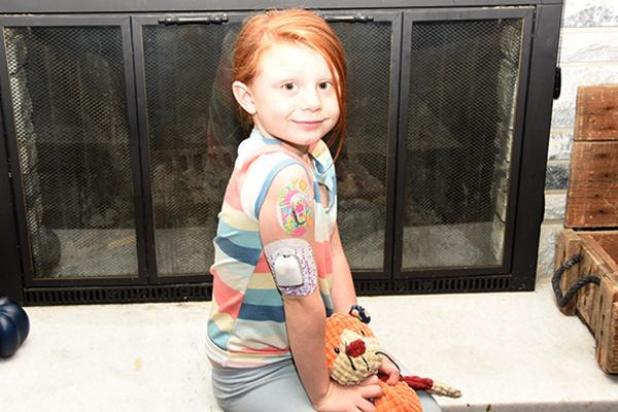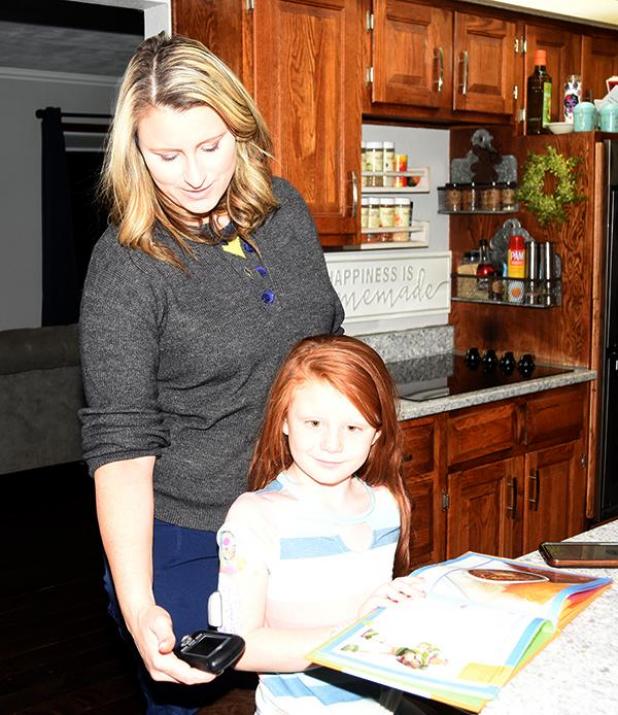
Loxley Ring is pictured with her teddy bear, Izzy, her first stuffed animal. Her continuous glucose monitor is on her shoulder, and her insulin pump is below it. — The Holyoke Enterprise

Sara Ring, at left, uses her daughter Loxley’s personal diabetes manager, which Loxley named Rose. The device tells how much insulin has been administered when it is near Loxley’s insulin pump. — The Holyoke Enterprise
Loxley Ring’s journey with diabetes brings family closer together
November is National Diabetes Month, and communities across the nation are working to bring attention to the condition. According to the Centers for Disease Control and Prevention, 34.2 million people have diabetes in the U.S., about 10.5% of the nation’s population.
For paramedic Brady Ring and his wife Sara, cardiac supervisor at Melissa Memorial Hospital, their 6-year-old daughter Loxley’s diagnosis of Type 1 diabetes last July has affected all aspects of their lives.
“We didn’t know nearly enough,” Brady said in describing how they felt when they learned of the diagnosis, adding that it is likely even harder for those not in the medical field when they experience that in their family.
They described Type 1 diabetes as an autoimmune disease to which Loxley was predisposed. Brady said that sometimes a virus can attack the pancreas and trigger diabetes.
Type 1 diabetes means the person’s body doesn’t make insulin, while Type 2 can develop from an unhealthy lifestyle, causing the body to become resistant to the insulin it does produce.
Insulin breaks down glucose in the body and removes it from the bloodstream. Sara and Brady said those with Type 2 can potentially go without insulin shots if they eat right and exercise, and there’s also medicine they can take to make the insulin more effective.
Loxley also has celiac disease, where gluten attacks her body.
Sara said Loxley is supposed to have 40-50 grams of carbohydrates at most meals. She said gluten-free food is good for those with celiac disease, but it often has a lot of carbohydrates to make it taste better, which is not good for people with diabetes.
When Loxley was diagnosed, she had been exhibiting warning signs like bedwetting, weight loss and excessive thirst and hunger. Sara said they thought Loxley had a urinary tract infection since she had been swimming in rivers and lakes during the summer.
They had tests run at the Barbara Davis Center in Aurora, and glucose and ketones were in her urine samples. Brady said that once they got her blood sugar levels under control, the bedwetting stopped immediately.
They were sticking Loxley’s finger seven to eight times a day at the beginning, and she was getting shots of short-acting insulin in the arm with every meal and long-acting doses at night.
After a week of sticking her finger, they got a continuous glucose monitor, which checks her levels every five minutes and can be tracked on cellphones and shared with other key people like her teachers and her grandparents, Steve and Nora Deaver.
Loxley’s continuous glucose monitor and insulin pump are on her upper arm, and they put in a new pump and new insulin every three days.
They explained to Loxley that her pancreas, which the first grader called her “cancreas” for the first few weeks, stopped making insulin. She had been getting shots up until last week. The CGM has a catheter and transmits blood glucose level information from a drop of blood to linked phones.
“She has to have her cellphone with her all the time,” Sara said, noting that Loxley is young to have a cellphone, but it’s necessary. Loxley’s blood sugar level goal is 80-180 milligrams per deciliter. This goal requires quite a bit of planning in terms of timing when it comes to eating.
“A simple trip to Denver is not just a simple trip to Denver,” Brady said.
Sara and Brady explained that dosing, or increasing insulin levels, requires timing and planning. For example, if Loxley’s blood sugar level is 183, then Loxley waits 18 minutes before eating; if it’s 250, then she waits 25 minutes, dropping the last digit of her blood sugar level.
They also have to think of things that many people don’t consider at restaurants. If a soda fountain uses the same hose for all of its sodas, they have to make sure the hose is cleared before getting Loxley a diet soda to prevent any sugar from being in the drink.
Loxley carries a backpack with her everywhere she goes. It contains an emergency glucagon shot, nasal glucagon, fruit snacks and applesauce pouches. She also has a device called a personal diabetes manager with her at all times that tells how much insulin has been administered when it’s near her insulin pump.
Though the PDM took away the need for a lot of her shots, Brady said that she still has to have the shots if there’s a technical issue. Brady added that in many ways, Loxley’s diagnosis has brought their family closer together.
Loxley has five brothers, and she required at least one of them to hold her hand each time she received a shot.
“No matter what they were doing, they’d stop what they were doing to hold her hand,” Brady said.
“They’re a little over it now, but at first they were wonderful,” Sara added with a laugh.
When Sara and Brady spoke of the PDM, Loxley reminded them, “Her name’s Rose. Don’t forget.”
Sara and Brady explained that it was around 3 a.m. when they were discussing naming her PDM, and they thought Loxley was asleep, but she woke up briefly to tell them the PDM’s name is Rose.
Brady said there are many variables with diabetes — both known and unknown. These include Loxley’s activities, sleep, hormones, emotions and more.
“So many factors play into how the body metabolizes the carbs and how it responds to insulin,” Sara said, pointing out that they could do the same thing for six days and get different results on the sixth day than those on the first five.
Brady was quick to note that the support from the community and the school has been phenomenal.
Sara specifically cited her parents’ support as well as her sister-in-law, who has Type 1 diabetes, and Anita Lengfelder, whose son Pierce has Type 1 diabetes. Sara said that the people who have been where they are with diabetes are probably the best support.
Brady pointed out that Loxley’s diabetes didn’t happen overnight. He said her pancreas could have started to fail weeks or years before the diagnosis.
Sara said she recommends doing a quick finger stick at wellness exams to check glucose levels. “Don’t be afraid to ask,” she said, adding that all it takes is one drop of blood to warrant further testing. She said the warning signs were pretty obvious looking back, but parents can miss them.
They have no history of diabetes in their family, so family history is not a sure way to tell. She described the “Test One Drop” initiative, which seeks to bring awareness about diabetes and advocates for getting the simple and short process of getting one drop of blood tested at wellness exams.
Though Loxley said she doesn’t like diabetes since she “can’t eat that much sugar,” she has not let diabetes stop her from doing the things she really enjoys, like dance, gymnastics, going to the park, playing with Legos and going on walks with their dog Bailey. In school, she likes recess, art, music and PE. At the same time, she said one of the things she likes is not doing homework.
“She is very skilled at that,” Brady laughed.
Loxley continued to list her interests, including “pretend I’m tired when I’m doing homework, not go to school, snuggle with my dad, annoy him, annoy my mom by putting my feet under her feet.”
She also likes playing with her teddy bear, Izzy. “She was my first stuffed animal,” she said. “She likes hitting Dad.”
It was clear that Brady doesn’t mind a few hits from Izzy now and then, and despite the challenges that diabetes presents, the Ring family is closer as they work together to overcome them with doses of laughter and fun.
